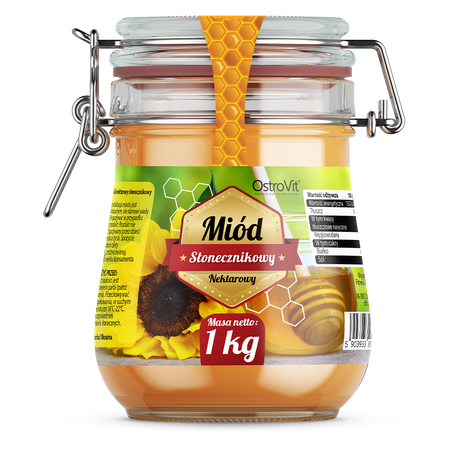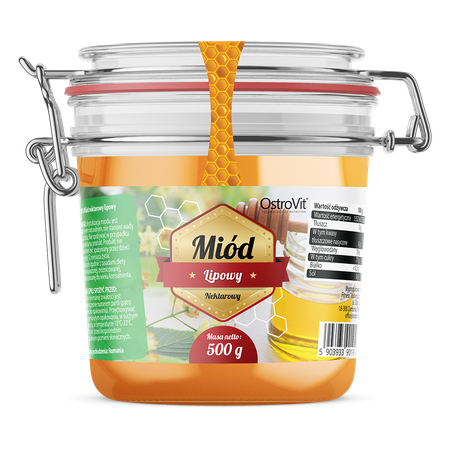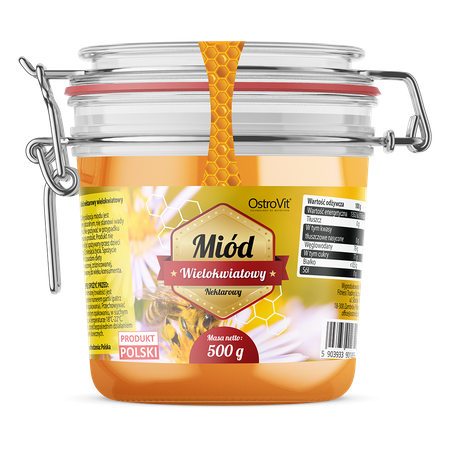Honey
Honey can be valuable sugar substitutes, because they are distinguished by their sweet taste and at the same time they are natural, ecological and may have health-promoting properties.
Honey is a sweet specialty produced by bees, which can provide the human body with numerous vitamins, minerals and valuable compounds.
For centuries, it has been recognized as a support for both body and soul. It is a natural antibiotic, the benefits of which are worth using every day.
What is honey?
Bee honey is a natural product made by bees from the nectar of flowers or honeydew. It is often called liquid gold.
Chemically, honey is a concentrated aqueous solution of sugars with hygroscopic properties.
The taste and aroma of honey are responsible for essential oils derived from nectar, as well as organic acids, sugars, amino acids, tannins and waxes.
For color, carotenoid compounds, xanthophyll and chlorophyll as well as flavonoids, anthocyanins and colloid substances.
What does honey consist of?
In honey many valuable components and substances can be distinguished. Exact composition of honey depends on the species of plant from which it comes. However, it can be theoretically assumed that in honey you can find compounds such as:
- water,
- monosaccharides,
- polysaccharides,
- minerals and trace elements,
- acids, vitamins, aromatic substances, amino acids,
- hormones such as acetylcholine or choline,
- flavonoid compounds - rutin, hesperidin, apigenin.
How is honey made?
It is well known that honey is produced by bees, but what exactly is the process of its formation?
Bees collect honey raw material in the form of nectar, honeydew or dew appearing on ears of grass.Then they moisten the product with a small amount of secretion derived from the salivary glands and place it in honey goiter.
In honey goiter, insects partially enrich the product with enzymes and organic acids, then transfer it to the hive and hand it over to the worker bees.
Workers thicken honey, that is, they introduce it several times into the honey goiter and move it to the root of the tongue. The process is also repeated by subsequent bees and then the honey is placed in the lower cells of the comb.
At this point, it evaporates and is then transferred to the higher cells of the patch. After filling it, the honey ripens - the water content decreases, and sucrose decomposes into monosaccharides.
When the honey ripens, the bees seal the cells with wax and then the combs are transferred by the beekeeper to the workshop.
Here, the slices are unsealed and go to the honey extractor, which spins the honey. Then the product is strained through sieves to then go to clarifiers where honey clarifies for a day and air is released from it.
Weaned honey goes into sealed containers and is ready to eat.
Honey properties
Both bees and beekeeper have to put a lot of effort to create a valuable product, which is honey. So what are the properties of this sweet specialty?
Honey can strengthen the body, support the work of the immune system and also have antibacterial activity. In addition, it can fasten wound healing processes and have anti-inflammatory effects.
Honey can also be a source of flavonoids and antioxidants, and thus can support the body in the fight against free radicals and reduce oxidative stress and eliminate reactive oxygen species.
The bee product can also strengthen blood vessels and provide the body with many valuable minerals, such as potassium, iron or calcium, as well as vitamins, i.e. B vitamins or vitamin C.
Honey can also support brain function, lower blood pressure, fasten body regeneration and relieve respiratory infections.
It is also used in cosmetics, as it can moisturize, brighten and improve skin elasticity, as well as soothe irritations and delay the aging process. Honey can also reduce sebum secretion.
Types of honey
Honey can be divided according to the type of raw material from which they were made into:
- Honeydew - are formed from deciduous or coniferous honeydew, that is, from plant sap processed by insects.
- Nectar - are formed in the nectary of plants from the nectars of flowers. They can be divided according to the plant species from which they were made.
More and more often you can also meet mixed honeys, i.e. nectar-honeydew.
Depending on the type of honey, its properties and application may be different
There are many different honeys. We can distinguish i.e.:
- Multiflower honey, which is formed from various plant species, usually growing near the apiary. This is one of the most popular honeys consumed in Poland. It may contain vitamins such as vitamin A, C or B vitamins, as well as many valuable minerals i.a. calcium, iron, magnesium or phosphorus. Consumed regularly, it can strengthen the immune system and in states of fatigue it can be a good source of energy. It is distinguished by a mild taste and usually a bright yellow color.
- Lime honey is obtained from linden flowers. It can be used during colds due to its expectorant and antipyretic properties. It can also have a positive effect on the nervous system and help you fall asleep. It usually has a spicy-sweet taste and yellow color.
- Sunflower honey is nectar honey obtained from sunflower flowers. It may have antibacterial and anti-inflammatory effects, as well as support the work of the circulatory system. Its taste is quite delicate and the color is bright.
- Rapeseed honey is obtained from rapeseed flowers. It has a creamy color and a mild taste with a delicate hint of bitterness. It can support the work of the heart, strengthen the circulatory system, and also show cleansing properties. It can also be helpful in inflammation of the urinary system. Rapeseed honey can crystallize quickly.
- Buckwheat honey is obtained from buckwheat flowers. It is distinguished by a rather sharp taste and dark color. As the only honey, it can contain rutin - a chemical compound, which can strengthen blood vessels and prevent the formation of an enzyme that can destroy vitamin C in the body. Buckwheat honey can also support the body's detoxification processes.
- Acacia honeyis obtained from acacia flowers. It has a light color and slowly crystallizes. It is also distinguished by a mild, sweet taste, thanks to which it is eagerly consumed by children.
It can be anti-inflammatory and support the digestive system. It may also have antibacterial and diuretic properties.
Use and storage of honey
Honey is a valuable product that is worth including in the daily menu. How to use it so that it does not lose valuable nutritional values? And how to store it to maximize its durability?
It is important to add honey to cooled drinks never to hot ones. At temperatures higher than 60 degrees Celsius, the product may lose many valuable health properties. High temperature can reduce and even destroy i.a. antibacterial effects of honey. Therefore, it is best to add it to a liquid with a temperature of about 40 degrees Celsius.
Bee honey is very sensitive to sunlight, therefore, properly stored, it should be placed in a dry and shady place. Equally important is the temperature - honey should be stored at a maximum of 20 degrees Celsius, however, at a temperature not lower than 8-10 degrees.
It is not recommended to store the product in metal vessels, because the metal can adversely affect the taste and health of honey.




